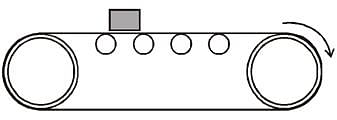JEE Main Physics Mock Test- 9 - JEE MCQ
25 Questions MCQ Test Mock Tests for JEE Main and Advanced 2025 - JEE Main Physics Mock Test- 9
A low-loss transformer has 230 volts applied to the primary and gives 4.6 volts in the secondary. Secondary is connected to a load which draws 5 ampere of current. The current (in ampere) in the primary is
A ball of mass 0.25 kg attached to the end of a string of length 1.96 m is moving in a horizontal circle. The string will break if the tension is more than 25 N. What is the maximum speed with which the ball can be moved
| 1 Crore+ students have signed up on EduRev. Have you? Download the App |
In a transformer, the number of turns in primary coil and secondary coil are 5 and 4 respectively. If 240 V is applied on the primary coil, then the ratio of current in primary and secondary coil is
A bullet of mass m and velocity V is fired into a block of mass M and sticks to it. The final velocity would be
If a person with a spring balance and a body hanging from it goes up and up in an aeroplane, then reading of weight of body as indicated by spring balance will
Assertion(A):A wire has a resistance of 12Ω. It is bent in the form of a circle. The effective resistance between two points on any diameter is 6Ω.
Reason(R): Equivalent resistance between two points on any diameter is in series.
Assertion(A): Refractive index of a material depends on the frequency of the light
Reason(R): Incoming e.m. wave applies an electric field and polarises it, contributing to (∈) permittivity of the medium, depending on its frequency.
We have two radioactive nuclei A and B. Both convert into a stable nucleus C. Nucleus A converts into Cafter emitting two αα-particles and three β-particles. Nucleus B converts into C after emitting one αα-particle and five β-particles. At time t=0, nuclei of A are 4N0 and that of B are N0. Half life of A (into the conversion of C) is 1min and that of B is 2min. Initially number of nuclei of C are zero.
Q. What are number of nuclei of C, when number of nuclei of A and B are equal?
'n' moles of an ideal gas undergoes a process A → B as shown in the figure. The maximum temperature of the gas during the process will be  Then the value of A is :-
Then the value of A is :-

In Y.D.S.E. using light of wavelength 6000Å angular fringe width of fringe formed on the screen is 1°. Find the distance between the slits :-
An electron moves in the field produced by a charged sphere of radius 10 cm along the radius connecting the points separated by 12 and 15 cm from the centre of the sphere. The velocity of the electron changes thereby from 2 × 105 to 2 × 106 m/s. Determine the surface charge (in nC/m2) density of the sphere. (Mass of electron = 9.1 × 10–31 kg)
You are given a converging lens with equal radii of curvature and a diverging lens with the same radii of curvature as those of the converging lens. The lenses are made of material with n = 1.50, and the radii of curvature are all 35 cm. They are placed at opposite ends of a tube 15 cm long, and the nearer lens which is converging is 10 cm from an object. What is the location of the image that results from the two refractions? Write the final distance (in cm) from diverging lens.
The new white belt of a long horizontal conveyor is moving with a constant speed v = 3.0 m/s. A small block of carbon is placed on the belt with zero initial velocity relative to the ground. The block will slip a bit before moving with the belt, leaving a black mark on the belt (figure). How long is that mark (in m) if the coefficient of kinetic friction between the carbon block and the belt is 0.20 and the coefficient of static friction is 0.30?

|
357 docs|148 tests
|
|
357 docs|148 tests
|





















